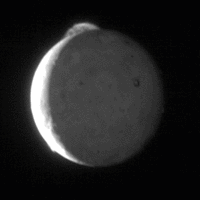Volcanism

The tidal heating produced by Io's forced orbital eccentricity has led the moon to become one of the most volcanically active worlds in the solar system, with hundreds of volcanic centers and extensive lava flows. During a major eruption, lava flows tens or even hundreds of kilometers long can be produced, consisting mostly of basalt silicate lavas with either mafic or ultramafic (magnesium-rich) compositions. As a by-product of this activity, sulfur, sulfur dioxide gas and silicate pyroclastic material (like ash) are blown up to 500 km (310 mi) into space, producing large, umbrella-shaped plumes, painting the surrounding terrain in red, black, and white, and providing material for Io's patchy atmosphere and Jupiter's extensive magnetosphere.Io's surface is dotted with volcanic depressions known as paterae.[62] Paterae generally have flat floors bounded by steep walls. These features resemble terrestrial calderas, but it is unknown if they are produced through collapse over an emptied lava chamber like their terrestrial cousins. One hypothesis suggests that these features are produced through the exhumation of volcanic sills, and the overlying material is either blasted out or integrated into the sill.[63] Unlike similar features on Earth and Mars, these depressions generally do not lie at the peak of shield volcanoes and are normally larger, with an average diameter of 41 km (25 mi), the largest being Loki Patera at 202 km (126 mi).[62] Whatever the formation mechanism, the morphology and distribution of many paterae suggest that these features are structurally controlled, with at least half bounded by faults or mountains.[62] These features are often the site of volcanic eruptions, either from lava flows spreading across the floors of the paterae, as at an eruption at Gish Bar Patera in 2001, or in the form of a lava lake.[64][5] Lava lakes on Io either have a continuously overturning lava crust, such as at Pele, or an episodically overturning crust, such as at Loki.[65][66]Lava flows represent another major volcanic terrain on Io. Magma erupts onto the surface from vents on the floor of paterae or on the plains from fissures, producing inflated, compound lava flows similar to those seen at Kilauea in Hawaii. Images from the Galileo spacecraft revealed that many of Io's major lava flows, like those at Prometheus and Amirani, are produced by the build-up of small breakouts of lava flows on top of older flows.[67] Larger outbreaks of lava have also been observed on Io. For example, the leading edge of the Prometheus flow moved 75 to 95 km (47 to 59 mi) between Voyager in 1979 and the first Galileo observations in 1996. A major eruption in 1997 produced more than 3,500 km2 (1,350 sq mi) of fresh lava and flooded the floor of the adjacent Pillan Patera.[32]

Analysis of the Voyager images led scientists to believe that these flows were composed mostly of various compounds of molten sulfur. However, subsequent Earth-based infrared studies and measurements from the Galileo spacecraft indicate that these flows are composed of basaltic lava with mafic to ultramafic compositions. This hypothesis is based on temperature measurements of Io's "hotspots", or thermal-emission locations, which suggest temperatures of at least 1,300 K and some as high as 1,600 K.[68] Initial estimates suggesting eruption temperatures approaching 2,000 K[32] have since proven to be overestimates since the wrong thermal models were used to model the temperatures.[68]The discovery of plumes at the volcanoes Pele and Loki were the first sign that Io is geologically active.[24] Generally, these plumes are formed when volatiles like sulfur and sulfur dioxide are ejected skyward from Io's volcanoes at speeds reaching 1 km/s (0.6 mps). Additional material that might be found in these volcanic plumes include sodium, potassium, and chlorine.[69][70] These plumes appear to be formed in one of two ways.[71] Io's largest plumes are created when sulfur and sulfur dioxide gas dissolve from erupting magma at volcanic vents or lava lakes, often dragging silicate pyroclastic material with them. These plumes form red (from the short-chain sulfur) and black (from the silicate pyroclastics) deposits on the surface. Plumes formed in this manner are among the largest observed at Io, forming red rings more than 1,000 km (620 mi) in diameter. Examples of this plume type include Pele, Tvashtar, and Dazhbog. Another type of plume is produced when encroaching lava flows vaporize underlying sulfur dioxide frost, sending the sulfur skyward. This type of plume often forms bright circular deposits consisting of sulfur dioxide. These plumes are often less than 100 km (62 mi) tall, and are among the most long-lived plumes on Io. Examples include Prometheus, Amirani, and Masubi.
No comments:
Post a Comment